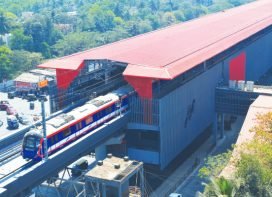 Just a few years ago, there was a raging debate against the Metro, as it was felt by many, that it may be an unnecessary expense for a city. Particularly, it was felt that the city should first establish a good bus service, after which higher order transportation solutions can be invested in. But the unprecedented rate of growth of private vehicles in Pune is amongst the highest in the country. Secondly, an international pressure for India to act against Climate Change has made it necessary for India to invest heavily into solutions that will cut down on carbon emissions.
Just a few years ago, there was a raging debate against the Metro, as it was felt by many, that it may be an unnecessary expense for a city. Particularly, it was felt that the city should first establish a good bus service, after which higher order transportation solutions can be invested in. But the unprecedented rate of growth of private vehicles in Pune is amongst the highest in the country. Secondly, an international pressure for India to act against Climate Change has made it necessary for India to invest heavily into solutions that will cut down on carbon emissions.
Arguments against Pune Metro have been numerous. Right from wrong routes to the elevated versus underground and the proposal for 4 FSI have all been debated and discussed for years among st Pune citizens and local media.
Take for example the argument of elevated versus the underground Metro. There has been a considerable lobbying for the underground Metro for Pune, citing predominantly the reason that elevated metro will disrupt the city considerably more, particularly during construction. V.B.Gadgil, who as head of L&T Metro executed the Hyderabad Metro, dispelled some of the myths associated with this argument. While citizens feel that the underground Metro will mean less disruption, underground stations cause the maximum disruption during construction. Underground Metro takes more time and hence the period of construction increases considerably. As against this, an elevated Metro station requires less time and also causes less disruption. Further, this work is faster and hence period of disruption can be considerably reduced, causing less inconvenience.
The second argument against elevated metro has been that it will cause a huge loss of tree cover to the city. Gadgil spoke about how the Rail height of a Metro can be decided based on various aspects of the city. These aspects will include the overall topography of the city but can also include other aspects like conservation of old and full grown trees. The Rail height can be worked out in the DPR that is usually prepared right before project execution.
The decision of making a Metro underground or the elevated is completely a techno-commercial decision and cannot be a political one. Technology today allows all kinds of options. The limiting factor is the affordability. While on one end, the citizens are talking about the unnecessary expense of the Metro, there is a section of citizens that is seeking an underground Metro at all costs. So, it seems like Pune’s arguments against the Metro are swinging a wide pendulum.
Key Statistics on Pune Metro
• Total corridor 1 length from PCMC to Swargate=16.59kms and corridor 2 which is from Vanaz to Ramwadi=14.92kms
• New metro alignment along the river which is under corridor 2 is 1.7kms. It makes up about 5.3% of the total Metro route length and approx. 11% of Corridor 2 length.
• It will be between the blue and the red line, where our city development control rules already allow some construction activity.
• The metro cantilever standard (squarish) column size=2.2 by 2.4 metres
Another major argument against the Metro has been the incentivization of 4.0 FSI offered in the Metro Influence corridor. This seemed like a four times jump to the existing 1 FSI of the city. However, when the final DC Rules for the city were published, it was found that the DC rules have completely changed the structure of FSI calculations. As against the earlier practice where there were numerous additions to the basic 1 FSI, the structure of the new DC Rules incorporated all these additions. Thus, when comparing the old and the new FSI, we find that there is only an incremental addition in the FSI in the Metro Influence Zone and not a four fold increase.
 TrafficInfraTech Magazine Linking People Places & Progress
TrafficInfraTech Magazine Linking People Places & Progress


